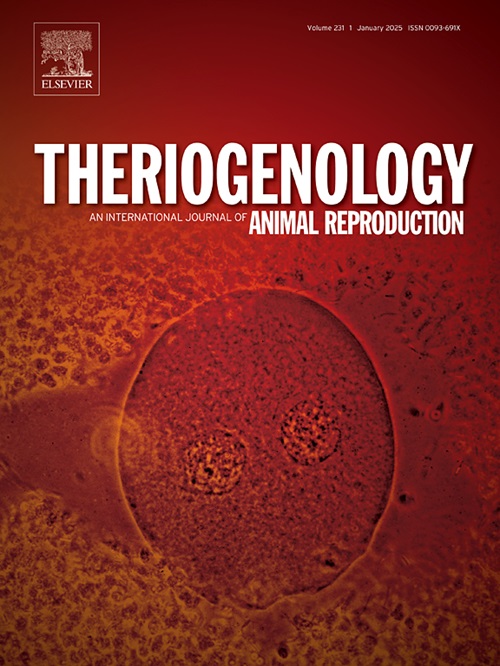在IVM培养基中添加n6/n3脂肪酸对牛卵母细胞和囊胚质量的影响
IF 2.4
2区 农林科学
Q3 REPRODUCTIVE BIOLOGY
引用次数: 0
摘要
优化体外成熟(IVM)培养基可以提高囊胚产量和质量。本研究探讨了在IVM培养基中添加两种必需多不饱和脂肪酸(LA和ALA)的混合物对牛卵母细胞、积云细胞(CC)和囊胚质量的影响,该比例在实验母牛血清中观察到。体外胚胎生产方案基于商业培养基(Bioscience, UK)。在100 μM LA + ALA的混合物中(75 μM LA + 25 μM ALA),以3:1的比例(75 μM LA + 25 μM ALA)成熟来自屠宰场卵巢的卵母细胞-积云复合物(COCs)。成熟后,选定的COCs在卵母细胞中进行活性氧(ROS)和谷胱甘肽(GSH)测量,并在CC中进行凋亡检测(TUNEL)。剩余的卵母细胞受精并培养到囊胚期,在囊胚期评估细胞计数和凋亡水平。我们的研究结果表明,LA + ALA混合物对卵母细胞(ROS水平降低)和囊胚(总细胞数(TCN)增加和凋亡指数(AI)降低)的特定质量参数有积极影响。然而,治疗对其他参数没有显著影响,如cc中的AI、卵裂和囊胚率或ICM: TCN和ICM: TE比率。本研究表明,中等剂量(100 μM)的脂肪酸(FA)对卵母细胞和囊胚有益。考虑到单个FA的相反影响和FA混合物的有限数据,我们的结果表明ALA可能抵消LA的不利影响。氧化应激和AI的缓解以及TCN的增加强调了在IVM培养基中优化FA补充的重要性。本文章由计算机程序翻译,如有差异,请以英文原文为准。
Effect of IVM media supplementation with a blend of n6/n3 fatty acids on the quality of bovine oocytes and blastocysts
Optimizing in vitro maturation (IVM) media can enhance blastocyst yield and quality. This study explores the effects of supplementing IVM medium with a blend of two essential polyunsaturated fatty acids (LA and ALA) at a ratio observed in the serum of experimental heifers on the quality of bovine oocytes, cumulus cells (CC), and blastocysts. The in vitro embryo production protocol was based on commercial media (Bioscience, UK). Oocyte-cumulus complexes (COCs) from slaughterhouse-derived ovaries were matured in a 100 μM LA + ALA blend at a 3:1 ratio (75 μM LA + 25 μM ALA). Following maturation, selected COCs underwent reactive oxygen species (ROS) and glutathione (GSH) measurements in oocytes and apoptosis detection in CC (TUNEL). The remaining oocytes were fertilized and cultured to the blastocyst stage, where cell counts and apoptosis levels were assessed. Our findings indicate that the LA + ALA blend positively influenced specific quality parameters in oocytes (reduced ROS level) and blastocysts (increased total cell number (TCN) and a lower apoptotic index (AI)). However, the treatment did not significantly affect other parameters, such as AI in CCs, cleavage, and blastocyst rates or ICM: TCN and ICM: TE ratios. This study demonstrates that a moderate (100 μM) fatty acid (FA) dose benefits oocytes and blastocysts. Given the opposing effects of individual FAs and the limited data on FA blends, our results suggest that ALA may counteract the adverse effects of LA. Mitigation of oxidative stress and AI and an increased TCN underscore the importance of optimized FA supplementation in IVM media.
求助全文
通过发布文献求助,成功后即可免费获取论文全文。
去求助
来源期刊

Theriogenology
农林科学-生殖生物学
CiteScore
5.50
自引率
14.30%
发文量
387
审稿时长
72 days
期刊介绍:
Theriogenology provides an international forum for researchers, clinicians, and industry professionals in animal reproductive biology. This acclaimed journal publishes articles on a wide range of topics in reproductive and developmental biology, of domestic mammal, avian, and aquatic species as well as wild species which are the object of veterinary care in research or conservation programs.
 求助内容:
求助内容: 应助结果提醒方式:
应助结果提醒方式:


